![]()
![]()
![]()
Use LEFT and RIGHT arrow keys to navigate between flashcards;
Use UP and DOWN arrow keys to flip the card;
H to show hint;
A reads text to speech;
24 Cards in this Set
- Front
- Back
|
Maxillary Second Molar
|
Mostly 4 cusp
Rhomboidal or heart shaped DL cusp is absent or very small 3 Roots: 2B (often fused) and 1L Right/Left: Large ML cusp, small DL cusp, and 3 roots make it easy to distinguish |
|
|
Maxillary First Molar
|
5 cusp (cusp of carabelli non-fnxal)
Rhomboidal shape Seperated by B developmental groove Cusp size: ML>MB>DB>DL 3 Roots: 2 B and 1L Right/Left: Large ML cusp, Large L root, and cusp of carabelli |
|
|
Maxillary Second Premolar
|
2 Cusp - usually equal in length
Lingual cusp usually tilts toward Mesial No mesial marginal ridge Occlusal table is more rounded than first premolar Root: 1 Root, it may tilt toward distal Right/Left: Tilt of Lingual cusp |
|
|
Maxillary First Premolar
|
2 Cusp - Buccal cusp is longest
Prominent buccal ridge Both cusp tips are shifted toward the mesial Right/Left: Mesial developmental depression and ligual cusp is tilted mesially Roots: 80% of max. first premolars have 2 roots |
|
|
Maxillary Canine
|
Distal cusp ridge is longer than mesial cusp ridge
Cusp tip points toward mesial |
|
|
Maillary Lateral
|
More narrow M-D
Distal incisal angle is more rounded Ingual anatomy is more prominent and sometimes a pit Root is longer than central's root |
|
|
Maxillary Central
|
3 developmental ridges
Larger M-D than C-I |
|
|
Mandibular Central
|
Smallest tooth in arch
No definite marginal ridges Very symetrical |
|
|
Mandibular Lateral
|
Resembles mandibular central but larger proportions
Incisal edge is "twisted" from the 90 degree angel with a line passing labiolingually through the tooth |
|
|
Mandibular Canine
|
More narrow than upper canine
Opposite from upper canine the cups tilts toward distal and has lingual inclination Has nearly straight mesial line angle Cingulum is less prominent than maxillary canine |
|
|
Mandibular First Premolar
|
"Snake eyes"
Most ill-defined lingual cusp Distinct feature: ML developmental groove Large buccal cusp centered over root tip Right/Left: Distal fossa is more developed and distal surface has a longer radius of curvature |
|
|
Mandibular Second Premolar
|
Can have 2 lingual cusp and mesial is larger of the two
With only one ligual cusp, the cusp is tilted toward mesial Lingual cusp is more prominent than the first premolar's lingual cusp Y-shape has central pit U and H-shape have developmental groove that crosses transverse ridge |
|
|
Mandibular First Molar
|
5 cusps: 3B 2 L
MB cusp is usually widest and generally largest of all 5 cusp Pentagonal occlusal outline 2 Root: 1D 1M |
|
|
Mandibular Second Molar
|
4 Cusp
2 Roots: Mesial root is thicker than the distal root Occlusal table: Mesial is more narrow than distal |
|
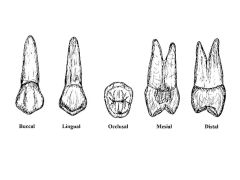
|
Maxillary Right First Premolar
|
|
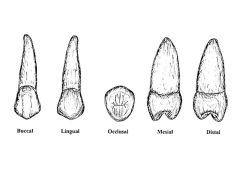
|
Maxillary Right Second Premolar
|
|
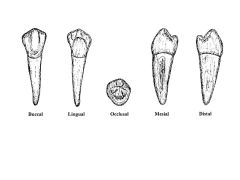
|
Mandibular Right First Premolar
|
|
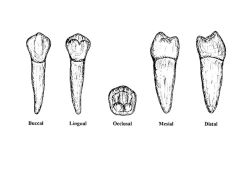
|
Mandibular Right Second Premolar
|
|
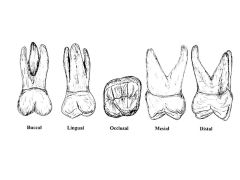
|
Maxillary Right First Molar
|
|
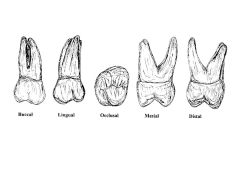
|
Maxillary Right Second Molar
|
|
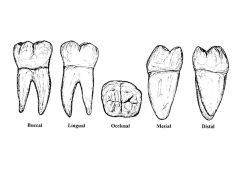
|
Mandibular Right First Molar
|
|
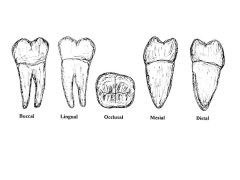
|
Mandibular Right Second Molar
|
|
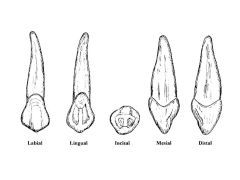
|
Maxillary Canine
|
|
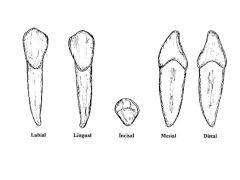
|
Mandibular Canine
|

